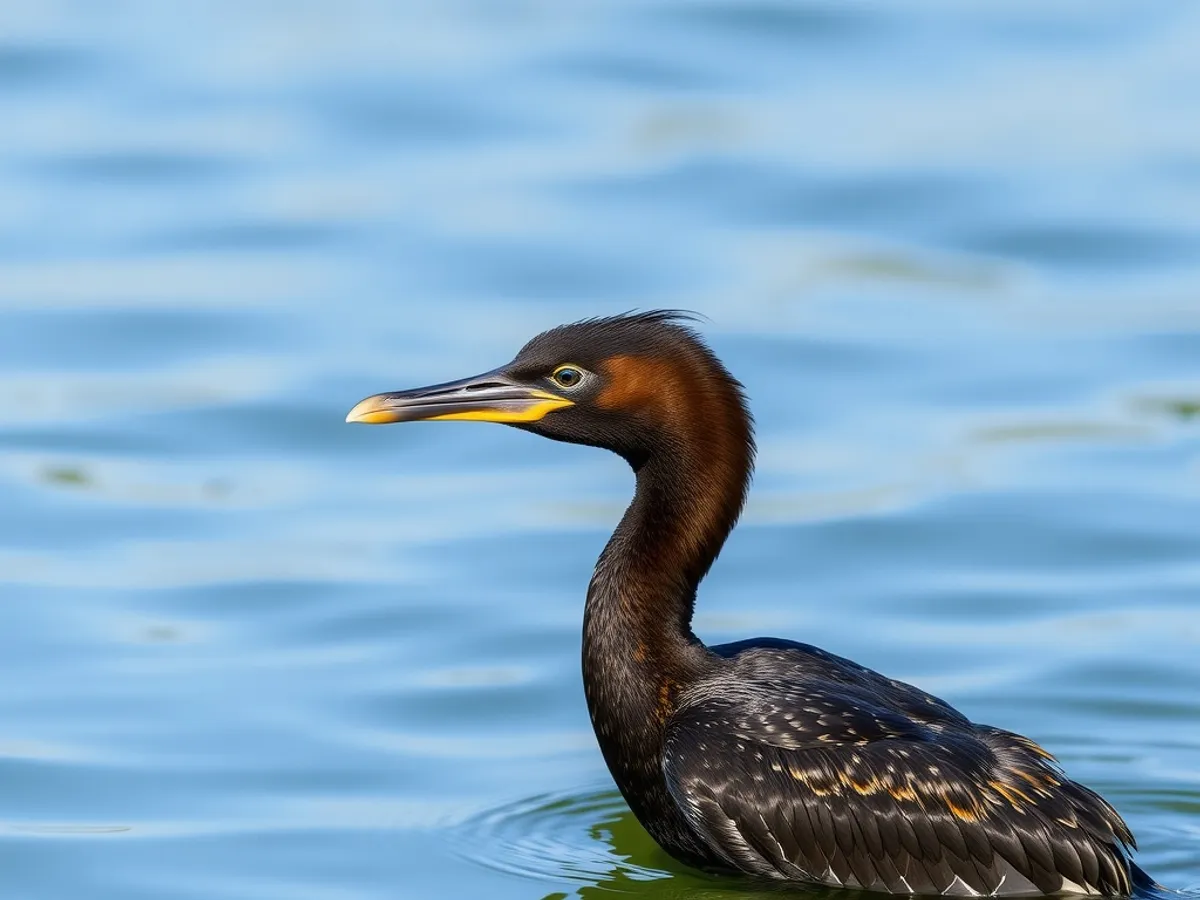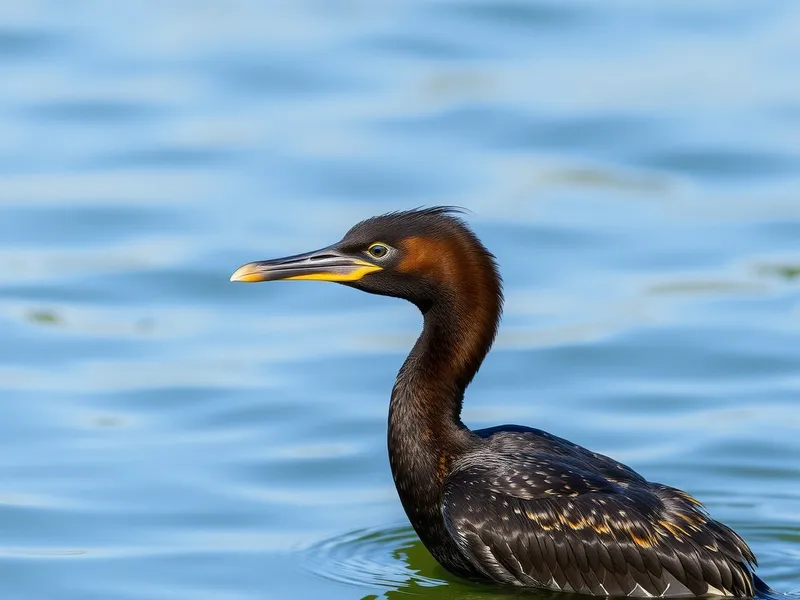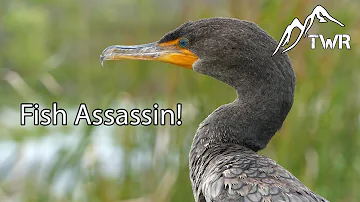
Double-crested Cormorant
Phalacrocorax auritus

Meet the Double-crested Cormorant
The Double-crested Cormorant is a large, dark water bird recognizable by its slender, hooked bill and striking turquoise eyes. During the breeding season, adults display unique double crests of black or white feathers on their heads. They are adept swimmers and divers, using their webbed feet to propel themselves underwater while hunting for fish. This species is highly adaptable, found in both freshwater and coastal environments across North America. They often gather in large colonies, nesting in trees, on cliffs, or on the ground near bodies of water.
Classification
Bird
Habitat
Lakes, rivers, reservoirs, coastal shorelines
Diet
Carnivore
Lifespan
6-17 years
Conservation
Least Concern
Weight
1.2–2.5 kg
📖Fascinating Facts
Unique Crests
The 'double crest' refers to two tufts of feathers that appear on either side of the head in breeding adults.
Expert Fisher
Double-crested Cormorants can dive up to 7 meters (23 feet) deep and stay submerged for over a minute while chasing fish.
Colony Nesters
They nest in large colonies, sometimes with hundreds or thousands of pairs, often alongside other waterbirds.
📋Detailed Description
The Double-crested Cormorant (Nannopterum auritum) is a robust, medium-to-large aquatic bird measuring 70–90 cm (28–35 in) in length with a wingspan of 114–123 cm (45–48 in) and a weight ranging from 1.2 to 2.5 kg (2.6–5.5 lbs). Its plumage is predominantly glossy black, with a subtle greenish or bronze sheen, and adults display a distinctive orange-yellow gular pouch at the base of the bill. During the breeding season, adults develop prominent double crests of black and/or white filamentous feathers on the sides of the head, a feature unique among North American cormorants. The species possesses striking turquoise to emerald-green eyes, and its long, hooked bill is adapted for grasping slippery prey. The feet are fully webbed, aiding in powerful underwater propulsion. Juveniles are brownish with pale underparts and lack the adult's crests and facial coloration. Double-crested Cormorants are highly social, often forming large colonies for breeding and roosting, and are known for their communal nesting in trees, on rocky islands, or on artificial structures. Their skeletal and muscular anatomy is specialized for diving, with dense bones that reduce buoyancy and allow efficient underwater pursuit of prey. After foraging, they are frequently observed perching with wings outstretched to dry, as their plumage is only partially waterproof. This species is highly adaptable, occupying a wide range of aquatic habitats, from inland freshwater lakes and rivers to coastal marine environments.
💡 Did you know?
The distinctive crests on Double-crested Cormorants only appear during the breeding season and can be either black or white, depending on the population.
🔬Research & Sources
Wikipedia Summary
The double-crested cormorant is a member of the cormorant family of water birds. It is found near rivers and lakes and in coastal areas and is widely distributed across North America, from the Aleutian Islands in Alaska down to Florida and Mexico. Measuring 70–90 cm (28–35 in) in length, it is entirely black except for a bare patch of orange-yellow facial skin and some extra plumage that it exhibits in the breeding season when it grows a double crest in which black feathers are mingled with white. Five subspecies are recognized. It mainly eats fish and hunts by swimming and diving. Its feathers, like all cormorants, are not waterproof, and it must dry them out after spending time in the water. Once threatened by the use of DDT, the numbers of this bird have increased markedly in recent years.
Last Modified: 5/24/2025
🎭Behavior & Social Structure
Double-crested Cormorants are diurnal and spend much of their day alternating between foraging, resting, and preening. They are pursuit divers, using their powerful legs and webbed feet to chase fish underwater, often reaching depths of up to 7.5 meters (25 feet) and staying submerged for 30–70 seconds per dive. Their diet is primarily piscivorous, targeting a wide variety of fish species, but they may also consume amphibians and crustaceans. Foraging is typically solitary, though individuals may aggregate in areas of abundant prey. Socially, they are gregarious outside of feeding, forming dense colonies that can number in the thousands during the breeding season. Cormorants are known for their characteristic wing-spreading behavior, which is thought to aid in drying feathers and thermoregulation. They communicate through a range of guttural croaks, grunts, and hisses, especially at nesting sites. Roosting occurs communally in trees or on exposed rocks and structures, often near water.
👶Reproduction & Life Cycle
Breeding occurs from early spring to midsummer, varying with latitude. Double-crested Cormorants are monogamous within a breeding season, with pairs forming shortly after arrival at the colony. Courtship displays involve ritualized posturing, bill clattering, and presentation of nesting material. Nests are constructed from sticks, reeds, and debris, often reused and enlarged annually. Clutch size ranges from 2 to 4 pale blue eggs, which are incubated by both parents for 25–28 days. Chicks are altricial, hatching naked and blind, and are brooded and fed regurgitated food by both adults. Fledging occurs at 5–7 weeks, though young may remain dependent on parents for several weeks post-fledging. High site fidelity is observed, with adults returning to the same colony and even nest site in successive years.
🛡️Adaptations & Survival
The Double-crested Cormorant exhibits several adaptations for an aquatic lifestyle. Its dense bones reduce buoyancy, facilitating deep diving. The partially waterproof plumage allows for easier submersion, though it necessitates frequent wing-drying. The hooked bill is specialized for capturing and holding slippery fish. Strong, webbed feet provide powerful propulsion underwater, while the tail acts as a rudder. Their keen vision, particularly adapted for underwater clarity, enhances hunting efficiency. Social nesting and colonial breeding provide protection from predators and facilitate information sharing about foraging locations. The species' broad ecological tolerance allows it to exploit a wide range of habitats, from freshwater to marine environments.
📚Research Sources
🎨Cultural Significance
While not as prominent in folklore as some other water birds, Double-crested Cormorants have been both vilified and protected by humans. In North America, they have been the subject of management controversies, particularly regarding their perceived impact on fisheries. In some indigenous cultures, cormorants are recognized as part of the natural aquatic community. Globally, cormorants have symbolic associations with fishing, adaptability, and resourcefulness. Unlike Old World cormorant species, the Double-crested Cormorant has not traditionally been used for fishing by humans.
🔬Recent Research & Discoveries
Recent research has focused on the ecological impact of expanding cormorant populations, particularly their interactions with fish stocks and nesting habitat selection. Studies using satellite telemetry have revealed long-distance dispersal and migration patterns, with some individuals traveling over 1,000 km between breeding and wintering grounds. Genetic analyses have clarified subspecies boundaries and population structure, supporting the recognition of five subspecies. Ongoing investigations examine the effects of environmental contaminants, such as mercury and PCBs, on reproductive success and chick development. Behavioral studies have explored the function of wing-spreading and social foraging dynamics. The species is also monitored as a bioindicator of aquatic ecosystem health.
🎥Wildlife Videos

Angry Birds: The Real Predators of the Rivers | Wild Italy | Episode 4 | Free Documentary Nature
Angry Birds: The Real Predators of the Rivers | Wild Italy | Episode 4 | Free Documentary Nature Watch 'Praying Mantis – The ...
Free Documentary - Nature

The Double Crested Cormorant: Ultimate Fish Assassin
One of the most uniquely adapted birds in the Southeastern US, the double crested cormorant has found a way to exploit a niche ...
The Wild Report

Cormorants: The World's Most Hated Birds
The redemption arc one of the world's most hated birds. Become an Animalogic member: https://bit.ly/AnimalogicMembership Get ...
Animalogic

Little Cormorant Bathing | Wildlife Documentary | Wild SB
Music: https://www.bensound.com https://www.facebook.com/SumithBandaraphotography #little cormorant #wild birds #water ...
Wild SB

great cormorant documentary
The great cormorant , known as the black shag in New Zealand and formerly also known as the great black cormorant across the ...
Sin nombre

Double-crested Cormorant Dries Its Feathers
For most birds, wet feathers are highly undesirable because they impede their ability to fly and don't provide insulation.
Cornell Lab of Ornithology
🌍Habitat Information
The Double-crested Cormorant typically inhabits Lakes, rivers, reservoirs, coastal shorelines environments. Double-crested Cormorants have adapted to their environments with specialized features and behaviors.
Primary Habitat:
Lakes, rivers, reservoirs, coastal shorelines
More detailed habitat information will be available soon.
🛡️Conservation Status
The Double-crested Cormorant is currently classified as Least Concern. Conservation efforts are crucial for preserving this species for future generations.
Common Threats:
- 🏠Habitat loss and fragmentation
- 🌡️Climate change impacts
- 🎯Hunting and poaching
- 🏭Human-wildlife conflict
⚠️Threats & Conservation Challenges
Historically, Double-crested Cormorant populations declined sharply in the mid-20th century due to the effects of DDT and other organochlorine pesticides, which caused eggshell thinning and reproductive failure. Since the ban of DDT, populations have rebounded dramatically, leading to new challenges. In some regions, cormorants are perceived as competitors with commercial and recreational fisheries, resulting in culling and nest destruction. Habitat loss, disturbance at nesting colonies, entanglement in fishing gear, and environmental contaminants remain ongoing threats. Despite these pressures, the species is currently classified as Least Concern by the IUCN, with stable or increasing populations across much of its range. Localized declines may occur due to human disturbance or habitat alteration.
🔬Scientific Classification
Scientific Name
Phalacrocorax auritus
Classification Hierarchy
🔍 About Taxonomic Classification
Taxonomic classification is a hierarchical system used by scientists to classify and organize living organisms based on shared characteristics and evolutionary relationships.
The system moves from broad categories (Kingdom) to increasingly specific ones, with each animal's scientific name typically consisting of its Genus and species.
📝Community Notes
Share your observations and insights about the Double-crested Cormorant with our community of wildlife enthusiasts.
Join Our Community
Sign in to share your observations and connect with fellow wildlife enthusiasts.
Sign In to ContributeNo community notes yet
Be the first to share your observations about the Double-crested Cormorant!
Explore Double-crested Cormorant
Select a tab above to learn more about this amazing animal.
📸Photo Gallery
No photos available for this animal yet.
🌟Discover More Wildlife
Continue your journey of discovery with more fascinating animals from our database
